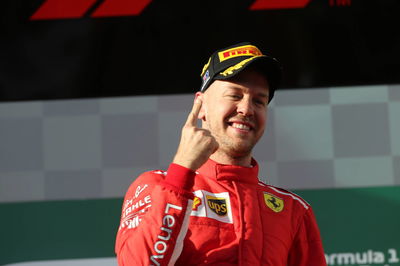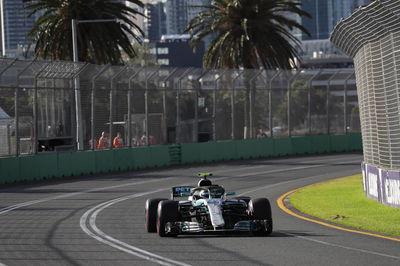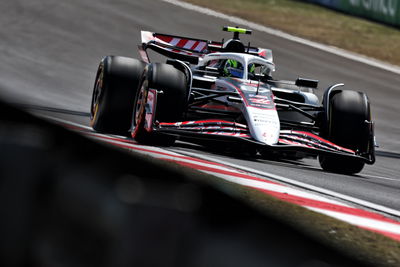F1 Race Analysis: How a perfect storm led to Ferrari victory
When I filed my race report for the Formula 1 season-opening Australian Grand Prix, I used the phrase “Ferrari nails its strategy” in the headline, which resulted in a bit of push-back on Twitter.
“How could Ferrari have nailed its strategy when it lucked into victory?"

When I filed my race report for the Formula 1 season-opening Australian Grand Prix, I used the phrase “Ferrari nails its strategy” in the headline, which resulted in a bit of push-back on Twitter.
“How could Ferrari have nailed its strategy when it lucked into victory?"
Well, it did. Ferrari played a perfect race today. There was absolutely no way it was capable of beating Mercedes in a straight fight. Lewis Hamilton made that much clear in the opening stint as he eked out a four-second buffer to Kimi Raikkonen behind in second place. He looked in control, and most of the media centre was already anticipating a win for the defending world champion and Mercedes.
But then a perfect storm played out for Ferrari and Sebastian Vettel to take an unlikely victory at Albert Park - a storm that started brewing in qualifying on Saturday.
THE COST OF BOTTAS’ CRASH
Mercedes team boss Toto Wolff’s biggest concern following Valtteri Bottas’ crash at the start of his first flying lap in Q3 on Saturday was - once the Finn had been checked and released from the medical centre - the possible psychological impact of the error.
Bottas entered the new season already facing questions about his future, and himself was eager to bounce back from a “disappointing” (his words, not ours) 2017 campaign where a mid-season dip in form left him well outside of the title fight come the end of the season. So to crash so early in the year was not the started he’d hoped for.
The mistake warranted a new gearbox that dropped Bottas to P15 on the grid, as well as eating into the driver’s allocation of energy stores and control electronics for the season.
But had a bigger impact on the fight at the front. Hamilton was now left all alone to fend off the twin-pronged attack from Ferrari.
“I know how hard Valtteri has been working and so I will know how difficult and the pain he will feel right now. He will recover for sure,” Hamilton said after qualifying.
“He was very quick through practice and he’s been putting a lot of effort into growing as a driver and as a member of the team. Definitely unfortunate, but I have all the confidence in him to pull through again tomorrow quite quickly.”
Bottas’ charge was stymied by the difficulty of overtaking at Albert Park, limiting him to P8 at the chequered flag. As well as the drop in points - Mercedes scored 22 to Ferrari’s 40 on Sunday - the lack of a second runner at the front had a big impact on Hamilton’s race. It allowed Ferrari to split strategies, paving the way for a Prancing Horse victory.
“To fight the Ferraris, the primary goal for the team is to win the constructors' championship. In order to do that, I can't do that, one driver can't do that one his own,” Hamilton said after the race.
“It's all about teamwork for sure. I don't know if that would have made much difference today, having Valtteri in there, who knows? He probably would have been in the top four with me, maybe even the front row, who knows? Maybe it would have made a difference.”
SELLING THE DUMMY
Raikkonen made a very racy start at lights out, managing to put pressure on Hamilton and even angle for a move around the outside of Turn 3. The Mercedes driver held position well, though, and was soon able to stretch the legs of the W09 Hybrid to forge a healthy lead.
Pre-race predictions anticipated the one and only round of pit stops to come around Lap 21, with the drivers starting on Ultrasofts able to then switch to Supersofts that would carry them to the end of the race. Ferrari opted to bring Raikkonen in early, though, servicing the Finn’s car at the end of Lap 18. The team decided to give Raikkonen Soft tyres to complete the race on, perhaps fearing a drop-off in pace on the less durable Supersofts.
Mercedes was now left with a dilemma: keep Hamilton out and risk Raikkonen getting the undercut; or bring him in, and potentially leave the door open for Vettel. With the second Ferrari some eight seconds down the road, Mercedes decided to head off the closest threat and covered off Raikkonen by pitting Hamilton at the end of Lap 19.
Ferrari was now in a good spot with Vettel. He started to pop in a few personal best laps as his Ultrasofts held up, stretching the stint out to seemingly be able to make the switch to Supersofts for the remainder of the race, giving him a tyre advantage. Tyre data also showed the Supersofts were in fact degrading slower than the Softs, losing 0.01s per lap compared to 0.04s for the harder compound.
Vettel kept putting in lap after lap, with the gap to Hamilton stabilising at around 12 seconds. It was by no means enough to get the jump in the pits; even the 17-second gap to Raikkonen would not be enough. But Vettel would have a decent pace advantage - and, more crucially, could benefit in the event of a Safety Car.
Ferrari had sold Mercedes a dummy it had no choice but to take. And the fruits of its labour would quickly come through.
RIGHT PLACE, RIGHT TIME
Moments before the Virtual Safety Car was called on Lap 26 following Romain Grosjean’s cruel twist of luck that forced him to park up at Turn 2, just one lap after Haas teammate Kevin Magnussen had befallen a similar fate, Vettel’s lead stood at 11.9 seconds.
The nature of the VSC slows all drivers down across the track. As Vettel was further up the road before pitting, with the rest of the field also going at a far slower pace than he would have been when Hamilton pitted, he was able to gain a huge advantage that would put the race in his hands.
The usual loss of time due to pitting came to around 22 seconds, meaning Vettel had to gain around 10 on Hamilton as a result of the VSC. The lap of his stop was 1:45.050; Hamilton’s time by comparison was 1:57.688 - a crucial difference of 12 seconds that allowed him to squeeze out ahead.
Mercedes was left ruing a software glitch that meant it did not calculate the right time window in the event of a VSC. The team believed Hamilton was going fast enough after coming out of the pits to still lead from Vettel if a VSC was called, and did not want him to push too hard for fear of chewing up his tyres.
“We calculated the VSC gap which was needed. Our computer said 15 seconds was what the necessary time in order to jump us,” Mercedes team boss Toto Wolff explained. “We were always within this three or four second margin. Then suddenly the cameras showed us the pit exit - Sebastian came out in front of us.
"We have no explanation yet. It could be an unlucky situation that Sebastian was just making it into the pits, was accelerating behind safety car line one and two. I don’t know… The software or system we have been using for five years just gave us the wrong number.”
FOLLOW THE LEADER
The margins were fine yet decisive. Hamilton was left baffled by how he had lost the lead of the race, asking if he did anything wrong. “We thought we were safe, but there was obviously something wrong,” was the explanation from the pit wall, with the defending world champion now tasked with recovering the position.
Mercedes’ race pace advantage was clear through the opening stint, but even that was not enough to be able to claw the position back. The nature of the 2018 F1 cars means dirty air is extremely turbulent, making it difficult to follow and even harder to overtake.
“Statistically I believe this is the second-hardest circuit to overtake on. You need something like a 1.8 second advantage or something crazy like that to be able to pass someone,” Hamilton said.
“I was as close as I could be, but the aerodynamics make it very tricky. Whenever I was getting just that little bit closer, he looked like he was struggling, but he was able to hold on. I was trying to keep the pressure on because I saw a couple of mistakes appearing at some point.”
Lewis Hamilton didn’t lose the Australian Grand Prix because of any wrong-doing on his part. He was perfect for much of the weekend, with the biggest blots of his copybook being the mistakes in the closing stages as he tried in vain to pile pressure on Vettel. What cost him victory was a miscalculation from the software used by the team.
“It’s such a team effort, but when you’re relying so much on computers, so much data, so much technology to come up with the strategy or whatever it may be, I wish it was down more to personnel,” Hamilton said after the race.
“I don’t know if that is the right saying, but I wish it was more in my hands because as I said I feel I was driving as good as ever today. Really really happy with how I was driving.
“Anyway, I will take that onto the next race, apply it exactly the same as I have this weekend and try to grow, try to grow within myself.”
Hamilton’s positivity may be tinged with disappointment given his defeat, but there is plenty to take heart from heading into the rest of the season. Mercedes looks to be the team to beat, and with a bit more luck, he’d have won today’s race pretty comfortably.
But instead, a perfect storm allowed Ferrari to capitalise and take a hard-earned victory. Yes, it was lucky - but the team nailed its strategy on both cars to snatch away a win that looked far out of reach at one stage on Sunday.











